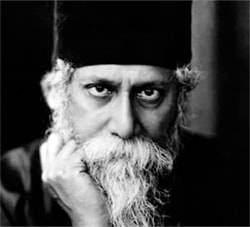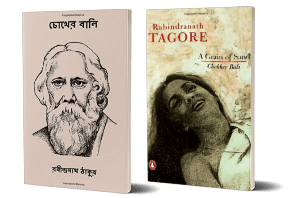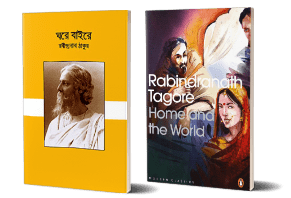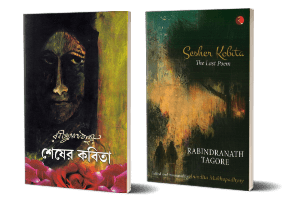May 7, 2019
Elsa Thomas
Tags
Rabindranath Tagore in Translation
Remembering the Bard of Bengal
 “Where the mind is without fear
“Where the mind is without fear
and the head is held high,
where knowledge is free.
Where the world has not been broken up into fragments by narrow domestic walls.
In to that heaven of freedom, my father,
Let my country awake!”
― Rabindranath Tagore, Gitanjali: Song Offerings
Rabindranath Tagore, author of the ‘profoundly sensitive, fresh and beautiful verse’ of Gitanjali became the first non-European to win the Nobel Prize in Literature (1913). The prolific artist enticed the Bengali audience with his wide-ranging poetry, stories, paintings which overturned the conventional ideas and practices in the society. Tagore’s assertive viewpoints on nationalism and his understanding of the feelings and emotions of the Indian woman and the attitude towards them in his works were remarkable. The tendency to question and contest ways of the world lead to the discontent with the formal education system. Thus, In 1901 he founded an experimental school in rural West Bengal at Shantiniketan, where he sought to blend the best in the Indian and Western traditions, which became Visva-Bharati University in 1921.
Tagore is also referred to as ‘The Bard of Bengal’. He modernised Bengali art by rejecting rigid classical forms and resisting linguistic limits. It was not just the structural alterations that Tagore initiated but also the thematic concerns. His works moved towards a stronger sense of realism by liberating the Bengali novel from its bondage of historical romance. His novels, stories, songs, dance-dramas, and essays spoke of topics, political and personal, and were popularly known for their lyricism, naturalism, and unnatural contemplation. Tagore’s novels are a radical statement of his unusual viewpoint which were ahead of the conservative times of 19th and 20th century India. Gora (1909), Ghare-Baire (1916), Choker Bali (1903) are some of his best-known novels. There have been several attempts to translate Tagore’s body of work into English, making it accessible to non-Bengali readers. In fact, Tagore himself translated many of his works into English.
Here’s a quick glance into some of Gurudev’s most popular novels:

CHOKHER BALI (1903)
Chokher Bali was truly a norm-defying novel with a narrative shaped through passion, desires and an intricate network of relationships. Tagore’s novels condemned many taboos and unjust customs which deprived widows of their rightful existence; confined to live a mournful colourless life. Chokher Bali presents the woeful conditions of Hindu widows and the emergence of a new type of woman in quest of self-fulfillment through Binodini, the protagonist of the novel. An extra-marital affair with a widow and the closer depiction of female friendship in the novel created a ripple in the society by shattering the conventional identity of a widow as well as unsettling the idea of a successful married life.
 GORA (1909)
GORA (1909)
Tagore’s longest novel, Gora, is a complex narrative with a rich philosophical debate on religion and politics. The concerns raised in the novel about the imagination of a nation seem very contemporary and compels one to question their concrete beliefs about a nation. The protagonists in the novel portray through their personal principles, a struggle for values in one’s own tradition. The novel accommodates questioning of various binaries like tradition and modernity, elite and the poor and presents an intersection of caste, religion, gender with nationalism.

GHARE BAIRE (1916)
The novel standing true to its title literally captures the concerns of the home, the outer world and the inter-relationship of both these spaces. The power dynamics within a household and the conflict between true and false patriotism within the nation form the prominent thematic thread of the novel. Influence of Western culture, as well as the revolution against it particularly in Bengal owing to the Swadeshi movement and the Partition of Bengal, comes across through personal narratives of the characters in the novel. The position of women in the Indian freedom struggle is examined through the woman protagonist who through the development of the novel undergoes a transformation. Tagore negotiates the various ideas of a ‘modern woman’ within a nationalistic scenario.
 SHESHER KABITA (1929)
SHESHER KABITA (1929)
Shesher Kabita is considered a landmark in Bengali literature. The novel primarily is about man-woman relationships and the institution of marriage. Tagore yet again shows a masterly command of the trysts of human relationships. The themes of love, trust, passion, lust, and companionship keep the narrative intact. Tagore has brilliantly weaved poetry with prose in this novel. The fusion of the two forms adds to the creative beauty in exploring the ideas of platonic love. Tagore’s choice of ending the novel in an unconventional manner suggested a new way of looking at relationships.
As we celebrate the birth of this multifaceted and revolutionary artist today, let us revisit and cherish the timeless contributions which altered the way our society and world thinks. Remembering the literary genius who weaved beauty and purpose in the most beautiful way.